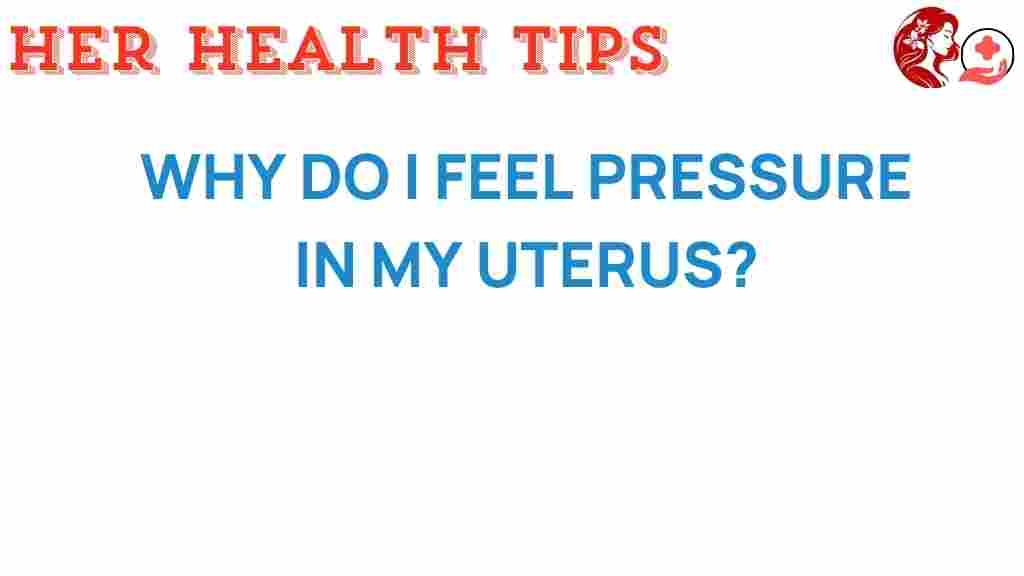Unraveling the Mystery: Why Do I Feel Pressure in My Uterus?
Experiencing uterine pressure can be a perplexing sensation for many women. This feeling can vary in intensity and may be associated with different stages of the menstrual cycle or various health conditions. Understanding the causes, symptoms, diagnosis, and treatment options is essential for maintaining optimal women’s health and pelvic health. In this article, we will explore the various aspects of uterine pressure, helping you to unravel this common mystery.
What is Uterine Pressure?
Uterine pressure refers to the discomfort or sensation of heaviness felt in the pelvic region, particularly around the uterus. This feeling can manifest as a dull ache, tightness, or a feeling of fullness. For some women, it may coincide with their menstrual cycle, while for others, it may occur independently of it.
Understanding Your Menstrual Cycle
The menstrual cycle plays a crucial role in women’s reproductive health. It typically lasts about 28 days, but it can range from 21 to 35 days. Hormonal fluctuations during this cycle can impact how you feel physically and emotionally, including the sensation of uterine pressure.
Common Causes of Uterine Pressure
There are several potential causes of uterine pressure, including:
- Menstrual Cramps: Many women experience pressure in the uterus during their period due to contractions that help shed the uterine lining.
- Ovulation Pain: Some women feel pressure or pain during ovulation, which occurs roughly halfway through the menstrual cycle.
- Pregnancy: As the uterus expands to accommodate a growing fetus, many women report feelings of pressure.
- Uterine Fibroids: These non-cancerous growths can cause significant uterine pressure and discomfort.
- Endometriosis: This condition occurs when tissue similar to the uterine lining grows outside the uterus, leading to pain and pressure.
- Pelvic Inflammatory Disease (PID): An infection of the reproductive organs can cause pelvic pain and pressure.
- Ovarian Cysts: Fluid-filled sacs on the ovaries can create pressure in the pelvic region.
- Pelvic Organ Prolapse: Weakening of pelvic floor muscles can cause organs, including the uterus, to drop, leading to pressure.
Symptoms Associated with Uterine Pressure
In addition to the sensation of pressure, other symptoms may accompany this condition. Common symptoms include:
- Aching or cramping in the lower abdomen
- Heaviness in the pelvic area
- Changes in menstrual flow (heavier or lighter periods)
- Intermittent sharp pains
- Back pain
- Difficulty urinating or frequent urination
- Discomfort during intercourse
If you experience any of these symptoms in combination with uterine pressure, it’s important to consult with a healthcare professional.
Diagnosis of Uterine Pressure
To diagnose the underlying cause of uterine pressure, a healthcare provider may perform various assessments, including:
1. Medical History Review
The first step often involves discussing your medical history and symptoms with your doctor. Be prepared to answer questions about:
- Duration and intensity of the pressure
- Associated symptoms
- Menstrual cycle patterns
- Any previous health conditions or surgeries
2. Physical Examination
A physical examination may include a pelvic exam to assess the uterus, ovaries, and other reproductive organs for any abnormalities.
3. Imaging Tests
Your doctor may recommend imaging tests such as:
- Ultrasound: This non-invasive test uses sound waves to create images of the reproductive organs.
- MRI: Magnetic resonance imaging can provide detailed images of the pelvic area.
4. Blood Tests
Blood tests can help identify hormonal imbalances or signs of infection that may contribute to uterine pressure.
Treatment Options for Uterine Pressure
The appropriate treatment for uterine pressure depends on the underlying cause. Here are some common treatment options:
1. Lifestyle Changes
In some cases, making lifestyle adjustments can alleviate symptoms. Consider:
- Regular exercise to strengthen pelvic muscles
- A balanced diet rich in fruits, vegetables, and whole grains
- Staying hydrated
- Managing stress through relaxation techniques like yoga or meditation
2. Medications
Over-the-counter pain relievers, such as ibuprofen or acetaminophen, can help relieve discomfort. If your doctor identifies a specific condition, they may prescribe:
- Hormonal contraceptives for menstrual-related pressure
- Antibiotics for infections
- Medication for endometriosis or fibroid management
3. Physical Therapy
Pelvic floor physical therapy can be beneficial for strengthening pelvic muscles and addressing issues like pelvic organ prolapse.
4. Surgical Options
If conservative treatments are ineffective, surgical options may be considered, such as:
- Myomectomy for fibroids
- Laparoscopy for endometriosis
- Hysterectomy for severe cases
Troubleshooting Tips for Managing Uterine Pressure
Here are some practical tips to manage the sensation of uterine pressure:
- Keep a Symptom Diary: Track your symptoms, menstrual cycle, and any potential triggers to discuss with your healthcare provider.
- Practice Relaxation Techniques: Stress can exacerbate symptoms, so consider mindfulness, deep breathing, or meditation.
- Stay Active: Engage in regular physical activity, which can improve overall pelvic health.
- Consult a Specialist: If symptoms persist, consider seeing a gynecologist or a pelvic health specialist.
Conclusion
Feeling uterine pressure is a common experience for many women, often influenced by various factors related to the menstrual cycle, hormonal changes, and underlying health conditions. Recognizing the causes, understanding the associated symptoms, and seeking appropriate diagnosis and treatment are vital steps in maintaining your pelvic health and overall women’s health.
If you find yourself struggling with persistent uterine pressure, do not hesitate to reach out to a healthcare provider. They can help you navigate your symptoms and determine the most effective treatment plan. Remember, prioritizing your health is essential, and you don’t have to face these challenges alone.
For more information on women’s health issues, consider visiting womenshealth.gov for resources and support.
Additionally, if you’re looking for more insights related to pelvic health, check out our article on understanding pelvic floor disorders.
This article is in the category Reproductive and created by HerHealthTips Team
